Thursday 29 February
My plan had been to spend the day trail walking. I awoke to gale force winds and rain.

Although I have waterproof gear for riding the bike it is not suitable for walking. So, a day spent sheltering indoors to write my diary and update the blog. And for eating: poached eggs on toast for breakfast, grilled chicken salad for lunch and a sumptuous Porterhouse (sirloin) steak for dinner.
It rains in Strathgordon on average 280 days a year hence its ideal location for hydro electricity generation. The locals wrote a rhyme some years ago:
Dirty days hath September
April, June and November
February is quite alright
It only rains from morn ‘til night
And if any month had thirty two
They’d be bloody raining too!
Friday 1 March
Strathgordon – Strahan
It was raining and the temperature was 14C when I left. It was a totally different experience riding the superb road to that of two days earlier. Great care was required on bends because of the wet road and of views masked by the rain and low cloud. The temperature fell as I gained height and entered low cloud and it fluctuated as I rode the 57 miles (92kms) to Westerway where I refuelled as I had on entering. It had reached 19C by then and had stopped raining. I joined the Lyell Highway after a while which crossed valley floors containing farms, and moorland and forests in the hills. Most impressive was Wentworth Forest where the road twisted and turned over steeply undulating terrain. The aromas in the wet woodlands were amazing. By early afternoon the rain had stopped and the sun appeared. The temperature though, rarely reached 20C and I stopped to put on my fleece. (I guess I have acclimatised quickly to the higher Australian temperatures.). My hands were still cold from the morning’s riding. It was only now that I was able to contemplate taking photos, my gear having been well stowed away from the rain.
I passed a number of lakes, many used by Hydro Tasmania for electricity generation, and rode through the stunning scenery of the Franklin-Gordon Wild Rivers National Park. I crossed Lake Burbury on the Bradshaw Bridge
and rode down a spectacular series of hairpin bends from Gormanston to Queenstown where I refuelled.
The road from Queenstown to Strahan was sublime and I was really in the groove where each bend seemed to be taken at just the right speed and it all flowed effortlessly. It proved yet again that even on a relatively low powered and unsophisticated motorcycle tremendous fun can be had. I rode along the Esplanade of Strahan (pronounced ‘Strawn’ I discovered a few days earlier) before booking into my accommodation. The proprietor was an elderly chap whose father had emigrated from Scotland many years before and he engaged me in a lengthy conversation about names and nationalities before showing me to my room. I ate in the hotel restaurant and selected Flake from the menu. I had deduced that it was some form of fish and discovered that it was the Australian name for gummy shark. It had a firm, dense flesh, similar to Huss at home, was delicious and was served, unsurprisingly, with chips and a token salad.
340kms travelled.
Saturday 2 March
Strahan
I walked into town from my accommodation which took approximately 15 minutes on a lovely sunny if windy day.
and collected the boarding pass from the Gordon River Cruise office for the next day’s outing.
Huon pine is reputedly one of the most valuable timbers in the world. It grows only in the wet, temperate rainforests of South West Tasmania. ‘Lagarostrobus franklinii’ (its proper name) is not actually a pine and is the only member of its family, so a pretty unique tree which grows extremely slowly, averaging just 1 millimetre in girth per year. They can grow to be 2,500 years old which means some of them started life BC! Add to this the fact that they do not start to reproduce until 600 to 800 years of age and you have a very special tree whose timber also has remarkable properties. It has a very high oil content, methyl eugenol to be precise, which renders it impervious to insects, waterproof, and imbues it with its characteristic sappy perfume. The high oil content also means the timber can be bent, shaped, worked and sculpted without splitting and finishes to a superb, fine lustre. The early settlers discovered the remarkable properties of Huon Pine and saw its potential for boat building, resistant as it was to the perennial problems of the boat builder, marine borer and screw worm. It turned out to be the best boat building timber in the world and was exploited heavily in the early days, driving a huge industry based on this ‘green gold’. Interestingly, concern for the future of these venerable giants started early in the last century – even back then it was apparent that there would be no next generation of trees to be had, their slow growth precluding the possibility of plantation farms. The felling of green Huon Pines stopped completely in the 1970’s after a consensus that it was neither sustainable nor prudent to cut down trees that were 1000 years old. However, a careful stockpiling operation was begun when trees were felled and collected prior to the flooding of several valleys to create dams for hydro electric schemes. For decades these logs were tied into huge rafts and left to float undisturbed on the water until needed. The stockpile created when Lake Gordon was flooded in 1972 still supplies the majority of logs released for use each year. The retrieval of stumps left over from old logging is another source of salvage timber and led to the discovery of tons of ancient buried Huon pine logs, some dated at 38,000 years old and still intact despite being buried in the damp earth all that time. I chatted to the Morrison giving the demonstration, in his sixties and the third generation of the family involved in the business, then watched the demonstration which involved the cutting of a log into planks using a massive reciprocating saw which was originally steam powered but which had been converted to be driven by an electric motor. The UK H&S Executive would have had kittens looking at some of the machinery used in the sawmill. There were blocks of beautiful wood, including myrtle, blackwood, sassafras and of course huon pine for sale. I would have loved to have bought some for my stick making but touring by motorcycle precludes the acquisition of anything but the smallest item. (I apologise for this overly long segment on huon pine, but I am fascinated by wood and the story of this tree I find particularly interesting.). On return to the hotel I ate a dinner of mixed seafood with a salad. I joined an elderly couple (actually just 2 years older than me) from Melbourne at their table and during our conversation they revealed that one of their daughters, Chloe McCardel, holds multiple marathon swimming World Records. She has the world record for swimming the English Channel 44 times (includes 35x single, 3x double and a triple non-stop crossing) and for the longest non-stop ocean swim (124km in 42hrs). (https://chloemccardel.com/ ). Needless to say they were extremely proud of her.
Sunday 3 March
Strahan
I was up at 0640 as I had to be at the waterfront in town at 0800 for my Gordon River cruise. I looked out to torrential rain which didn’t augur well for the cruise. I had booked it online several days earlier and had plumped for Sunday rather than Saturday because the weather forecast at the time suggested that the weather might be better. Wrong! By the time it came to walk into town the rain had stopped although it was very windy. I had booked an upper deck premium seat (required a second mortgage to pay for it but it was a one off experience after all) which turned out to be very luxurious and with a great view of the rain outside – it had started again by then.
The price included a continental breakfast, buffet lunch, and unlimited hot and cold drinks, including wine and beer throughout. We had reduced visibility because of the weather but the twin hulled craft was very stable and we travelled at 25 knots across MacQuarie Harbour.
Macquarie Harbour is the second-largest natural harbour in Australia, six times the size of Sydney Harbour. However, its real glory is not its size, but its setting, surrounded by rugged mountains, ancient forests, wild rivers, and fascinating histories of convicts, mining, huon piners, and hydro. We reached the extremely narrow harbour entrance named Hell’s Gate
where we saw extensive stone walls and breakwaters installed with the help of convict labour in the 19th century.
By this time we were enjoying sunny intervals and as we travelled back across the harbour we saw a number of fish farms rearing salmon and sea trout.
These are a source of some controversy because of their supposed detrimental effect on the ecology of the harbour caused by its minimal tidal flow, the result of such a narrow harbour entrance. The water within the harbour is also very brown because of the flow of fresh water from the rivers containing leaf matter etc collected as water filters through adjacent land. As we entered the Gordon River the boat switched to electrical power.
We stopped for a forest walk
P.S. During the visit to Bruny Island (27 February) we stopped at a lagoon to view a couple of trees. The two trees, which still stand were used by James Cook and others to navigate to the outlet of Resolution Creek for the replenishment of fresh drinking water.
Then
Now




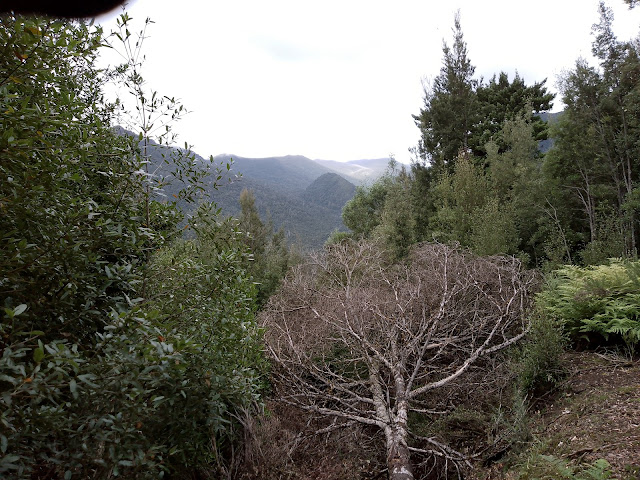




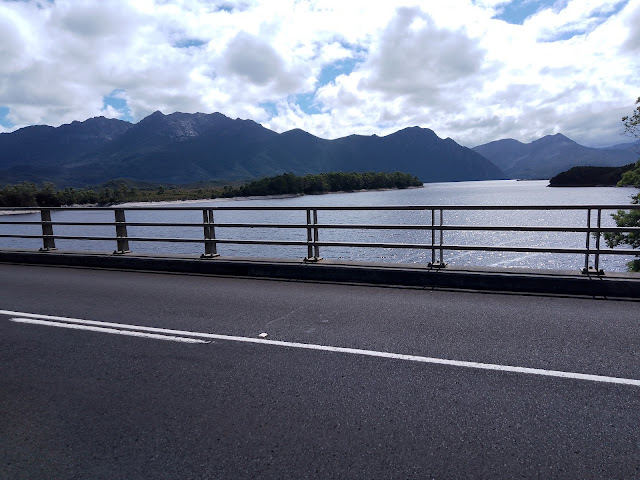

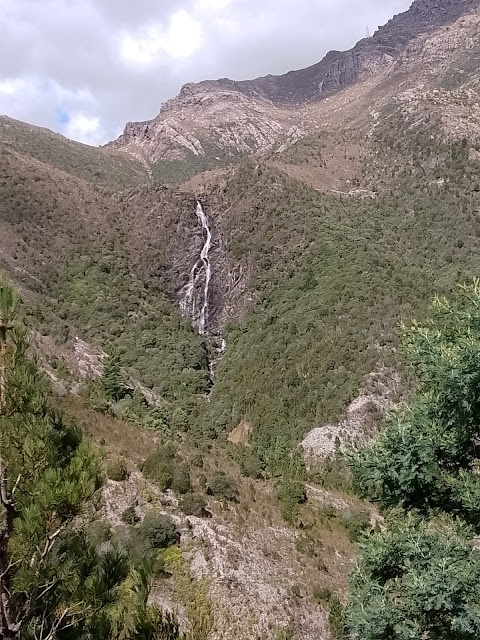



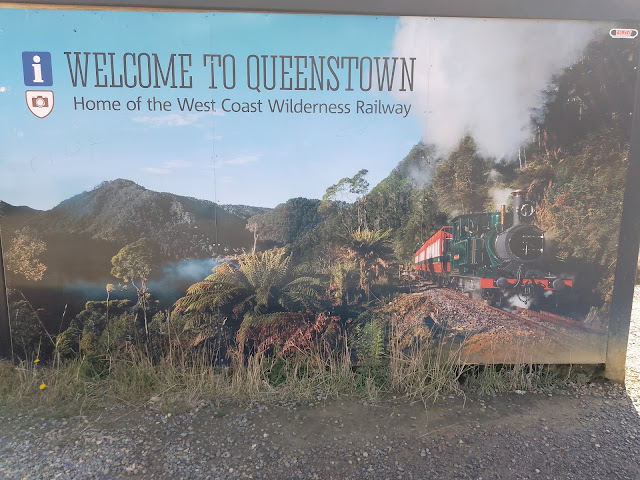




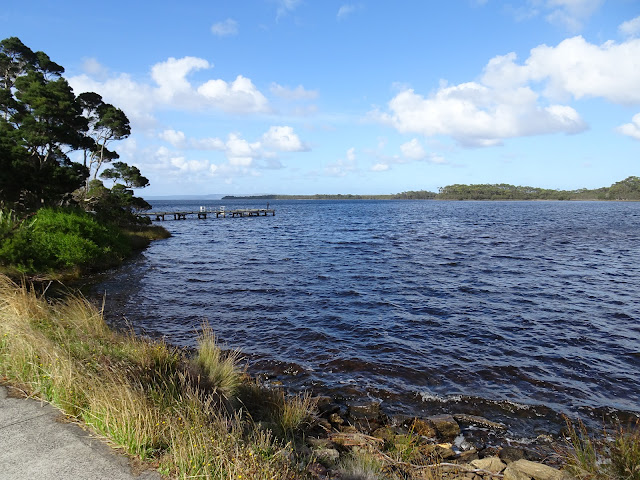














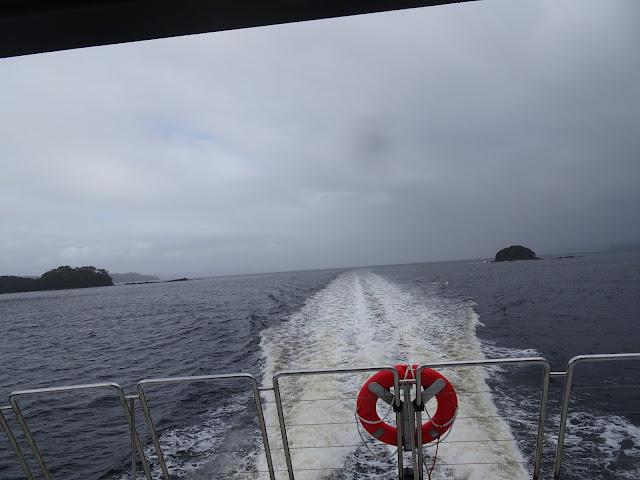













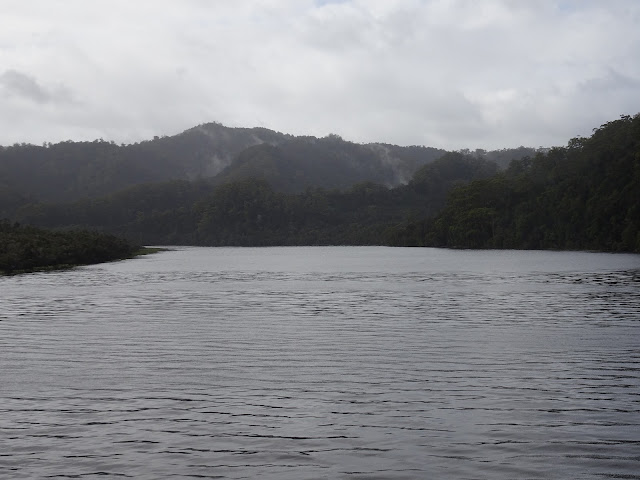
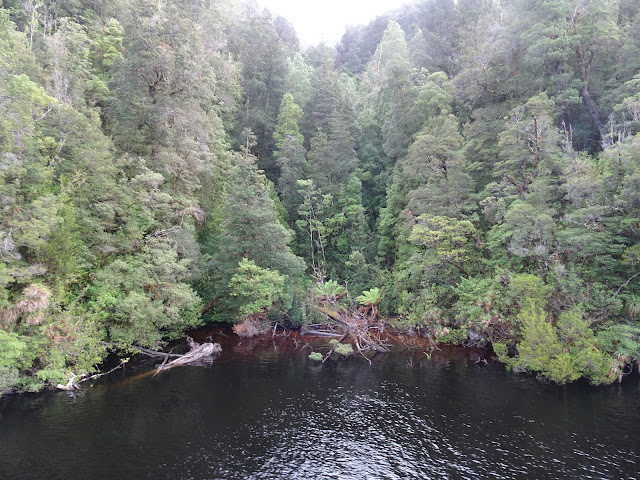



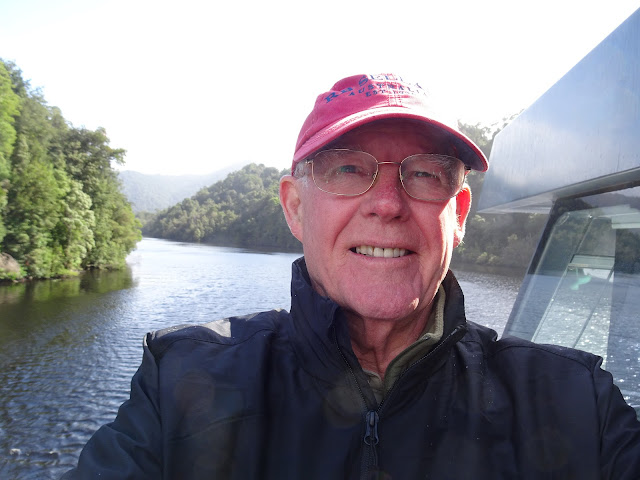












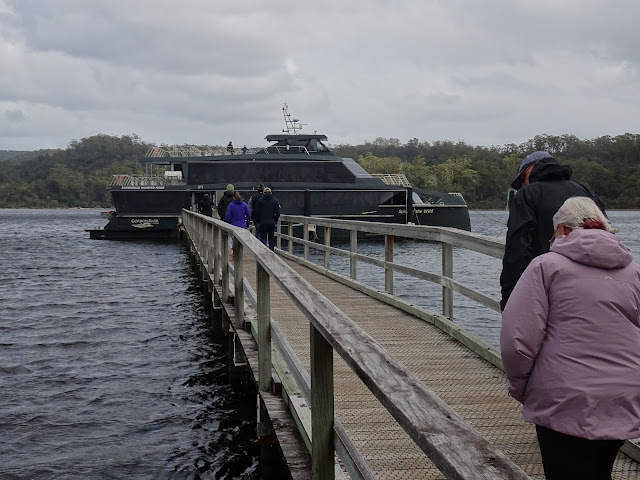


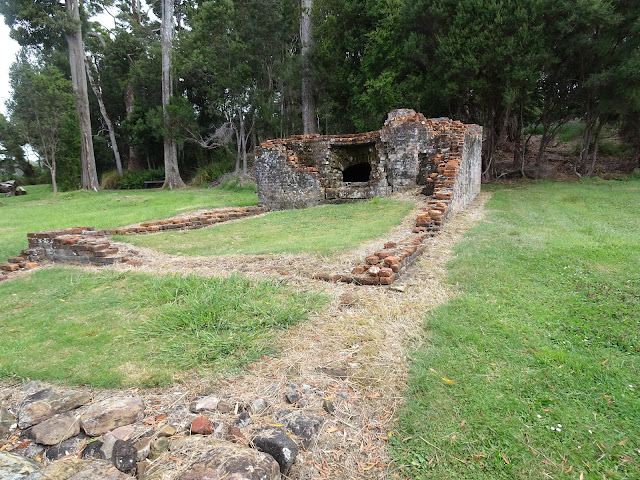




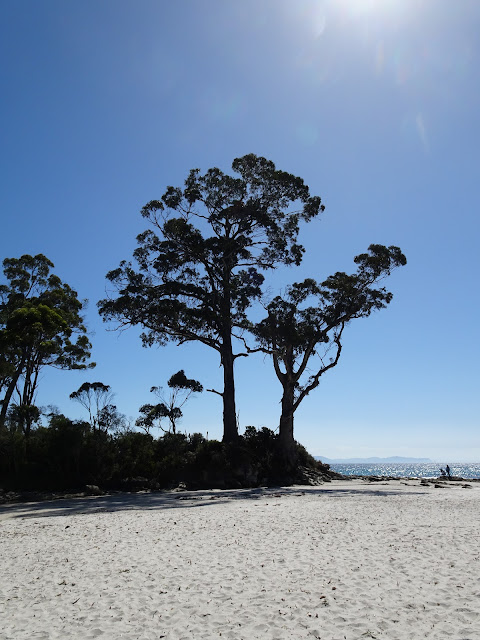
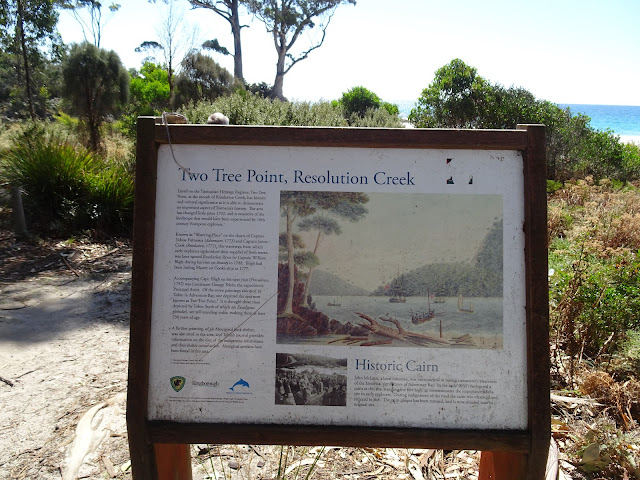
No comments:
Post a Comment